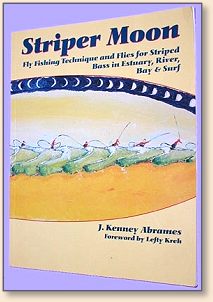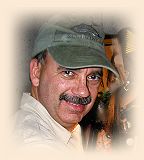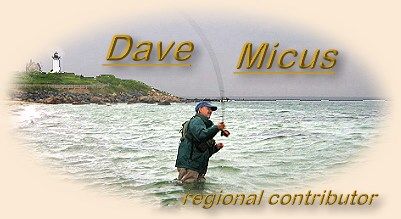|
North Eastern salt-water fly-fishing
is experience a quiet renaissance. There,
a small but growing group of anglers is
eschewing fast rods and sinking lines,
opting instead for the longer, softer rods
and floating lines of days gone by. They
forego the cast and strip method that has
become the norm of striped bass fishing,
returning to the controlled drift, wet fly
swing, and greased line methods more familiar
to traditional salmon angling. The techniques
have been around for hundreds of years, but
they are relatively new to the salt, and the
faithful swear that it is not only a more
challenging way to fish, but also more productive.
Done correctly, it raises the level of striper
fishing to near artistry.

Leading this renaissance is Rhode Island striper
legend, J. Kenney Abrames. That Kenney is the
foremost practitioner should come as no surprise,
as he is something of a renaissance man himself.
He is a painter and author and faultless tier of
beautiful flies; a serious man who exudes a quiet
dignity, and his expertise comes from fishing in
saltwater for over 50 years. Ken owned a charter
boat in the late 1960s, but quit when he saw "one
too many dead fish," took to fishing from the shore
with a fly rod, and has never looked back. He is
also single-minded in his conviction that striped
bass fishing shouldn't be restricted to the
monotony of repetitive casts and strips.

Ken brings a different perspective to the sport,
as witnessed by his eclectic contribution to the
fly-fishing literature, Striper Moon.
At a time when instructional books about salt-water
fly-fishing are as ponderous as calculus texts,
Striper Moon provides a breath of
salt air and exemplifies Ken's style; part instructor,
part artist, part philosopher. You don't just learn
how to fly fish for striped bass from reading
Striper Moon; you learn how to love
fly fishing for striped bass.
His web site, too, is a virtual example of his values
(www.stripermoon.com). The highlight is the bulletin
boards, covering every subject from old flies to
fishing politics. Cruise the board and you will
quickly notice a difference from other bulletin
boards. One note-worthy difference is Ken, himself,
responds to nearly every post. Another more subtle
distinction is there is virtually no flaming. Ken
might be the high priest of this neo-salmon fishing,
but the faithful are as committed as he. The goal
is to expand the salt-water fishing horizons, and
the mantra is 'together, we can get there from here.'
Perhaps the most striking example of Ken's commitment
is Tuesday Night Fishing, where, in-season, fly fishers
have the opportunity to fish with Ken every Tuesday
and learn from the master (which is a bit like hitting
the links with Tiger Woods).

The fishing methods have been around since Dame
Juliana, but were best articulated by A.H.E. Wood
in his book Greased Line Fishing for Salmon
published in 1931. This book, along with Striper Moon
is the bible of the neo-salmon guild. While some
of the methods are older than the split bamboo rod,
Wood was really the first to master the mend. To
do so, he coated his silk line with cerolene so it
would float (hence the greased line in his books
title), which allowed him to mend line in a way
not possible with sinking lines. The new striped
bass fishers have added old methods like the wet
fly swing, the dead drift, and the greased line
swing combined with newer methods like the Leisernring
lift to their repertoire. The aim is to have the
fly swim through the current as a natural baitfish
would through mending, dead drifting and line
manipulation. Practitioners swear it's a more
gratifying way to fish.

One glance at an Abrames fly and you can further
see the influence of traditional salmon angling.
Abrames' flies are tied using the flat wing method,
with long saddle hackles and sparse bucktail, and
their blending of colors along with their traditional
jungle cock eyes results in a remarkable mix of
impressionistic and kinetic art, as opposed to
the dumb-bell-eyed and epoxy coated salt water
flies that are the hallmark of today's salt water
tying style. The harshest critics, the linesiders,
love them.


"I don't know exactly when I started tying flatwings
but I do remember the dissatisfaction I felt with
the way streamers moved and looked in the water,"
Abrames says in his book on fly tying, A Perfect
Fish. "I always wanted my flies to swim
and look alive just like baitfish did." Abrames
began experimenting with tying flatwinged flies,
an obscure style briefly mentioned in Streamer
Fly Tying & Fishing, the seminal work by
Joseph D. Bates Jr., but relatively unknown to the
fly fishing world. But as often happens with
innovations, the idea was sound but the materials
to articulate the idea were not available. Abrames
worked with a producer of hackles to engineer the
perfect plume for flatwings, long, fine hackles
that would bring his creations to life. The result
is RLS Hackles (Ken prefers to use the old Latin name,
Roccus Leneatus Saxatilis when referring
to striped bass in lieu of the current Morone
Saxatilis, as he feels it 'better reflects
the spirit of the fish'). Now Abrames could communicate
his ideas about fly tying through his flies. The result
is a fly almost too beautiful to fish.

But all along the Eastern Seaboard these flies are
being fished, utilizing methods that would be familiar
to Theodore Gordon, and every day there are new
converts who believe that fly fishing is more
than just catching fish. I'm sure that, up above,
A.H.E. Wood is smiling.

(Note: All flies pictured in this article were
tied and photographed by John Kelsey, a prodigious
tyer of beautiful flies who will be the subject
of a future article.) ~ Dave
About Dave:
 Dave Micus lives in Ipswich, Massachusetts. He is an
avid striped bass fly fisherman, writer and instructor.
He writes a fly fishing column for the Port City Planet
newspaper of Newburyport, MA (home of Plum Island and Joppa Flats)
and teaches a fly fishing course at Boston University.
Dave Micus lives in Ipswich, Massachusetts. He is an
avid striped bass fly fisherman, writer and instructor.
He writes a fly fishing column for the Port City Planet
newspaper of Newburyport, MA (home of Plum Island and Joppa Flats)
and teaches a fly fishing course at Boston University.
|










 Dave Micus lives in Ipswich, Massachusetts. He is an
avid striped bass fly fisherman, writer and instructor.
He writes a fly fishing column for the Port City Planet
newspaper of Newburyport, MA (home of Plum Island and Joppa Flats)
and teaches a fly fishing course at Boston University.
Dave Micus lives in Ipswich, Massachusetts. He is an
avid striped bass fly fisherman, writer and instructor.
He writes a fly fishing column for the Port City Planet
newspaper of Newburyport, MA (home of Plum Island and Joppa Flats)
and teaches a fly fishing course at Boston University.